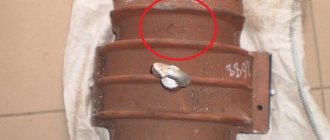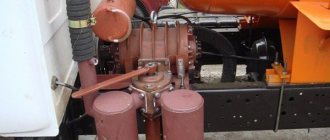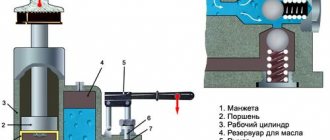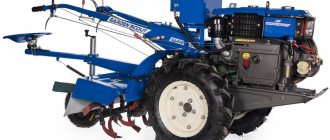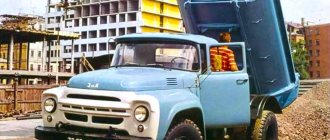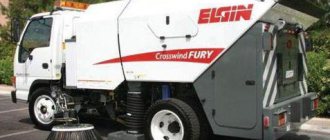In order to keep the city clean, today there are many types of municipal equipment. One of these types of equipment is a sewer truck - a type of special equipment that is used where there is no centralized drainage system, for example, in private sectors.
Having a sewer truck can be the start of your own business, since cleaning services for liquid household waste are popular. The purchase of such equipment will pay off in the first couple of years of use.
What it is?
A sewer truck (vacuum sewer truck) is a special vehicle that is designed for pumping and transporting sewage from sewers, settling tanks and cesspools. The pumping process itself occurs with the help of special intake hoses, as well as creating a vacuum in the tank of the machine itself.
The vacuum is created using a special vacuum pump (for example, “KO 503” or “KO 503v”). Actually, the name of the pumps determines the model of the sewer truck itself.
Equipment such as the GAZ sewer truck is found in almost every public utility. It is this brand of car that is so popular throughout Russia. And for large sewers, KAMAZ, MAZ and ZIL vehicles are used. Foreign analogues are also possible.
Video report
How to choose
The volume of the vacuum cleaner is selected according to the technical task. For large industrial facilities, equipment with maximum capacity is brought in to reduce the number of trips. This is a heavy 10 cubic meter sewer truck.
If you need to pump out a dry closet or a small septic tank, you can bring in a classic special vehicle with a 4-cubic-meter tank.
When choosing, you need to know exactly how much volume needs to be pumped out. This parameter should be told to the manager when submitting an application. Otherwise, you may face additional costs. The more flights the special equipment makes, the higher the cost of services will be.
Types of vacuum cleaners
It is important that the tank capacity of the machine matches the volume that needs to be pumped out. The smaller the car, the cheaper it is to pump out. The minimum volume of a GAS tank is 2 m³. The compact machine will fit into narrow passages and gates. Its light weight allows it to be driven onto paving slabs. Can pump out the volume of approximately 1 concrete ring with a radius of 1.5 m.
The most common car is GAZ with a tank volume of 4 m³. The septic tank hatch should be located at a maximum distance of 16 m from the tank.
Almost all brands of sewage disposal machines are equipped with hoses 10-15 m long. But often this is not enough. Therefore, owners equip their equipment with additional hoses; the average hose length is 20-25 m. The longer the hose, the greater the power loss. If the distance from the pumped-out container to the intended location of the machine is more than 25 m, a vehicle with a high-performance vacuum pump is required.
An important characteristic of a sewer pumping machine is fuel consumption. Japanese diesel models are practical because they do not consume fuel during pumping. They are equipped with convenient, automatically collapsing hoses. The tank of such a machine is durable because it is galvanized on the inside.
KO-520D
Vacuum machine KO-520D
Manufactured on the basis of the ZIL-497442 automobile chassis. The engine is weaker than previous options - 96 kW, also diesel. The volume of the tank is five cubic meters, the maximum depth to which the hose can be immersed is 4 meters.
The pump is capable of pumping 310 cubic meters in an hour, the tank is filled in 5 minutes. The weight of the vehicle in running order is 11 tons. There is no electronic equipment.
The engine of the machine complies with the Euro-3 environmental safety standard. The cabin is three-seater, the comfort of the seats is adjustable. The equipment is used to clean cesspools, participate in pipeline repairs, and clear silt from wells.
The operating principle of sewage disposal equipment
Vacuum trucks are used for pumping waste products from cesspools, sewers and waste pipes, for pumping water during the repair of water pipelines, flushing pipes, wells, wells from sludge contamination, and transporting all types of non-flammable liquids. Vacuum machines are typically operated by utilities and industrial companies.
For example, for cleaning channels with a large amount of mud sediments, the accumulation of which leads to emergency situations. In large cities where there is a centralized sewerage system, vacuum machines are not so in demand. In summer cottages and in private sectors it is difficult to do without them.
With the formation of large cities with central sewerage, drainage on roads and many enterprises, a need arose for specialized equipment that could fulfill a number of requirements:
- pumping and removal of waste from enterprises;
- elimination of consequences after sewerage accidents;
- elimination of flooding on roads after precipitation, when drainage networks cannot cope;
- pumping out various grease and starch traps (relevant for catering);
- pumping wastewater, waste pits and septic tanks;
You can list for a long time the various situations when the need arises to call a sludge sucker and sewage disposal machine.
Special fire and rescue vehicles
Fire rescue vehicles are ground transport systems used during emergencies of man-made and natural origin. This or that type of equipment in service with the Ministry of Emergency Situations is used to perform specific tasks:
- delivery of combat crews to the scene of the tragedy;
- reconnaissance activities to identify the extent of damage and identify dangerous areas;
- clearing the rubble of building structures and extracting victims from under them;
- provision of medical care;
- maintaining radio contact with headquarters;
- warning the population;
- removal of victims from the emergency site;
- stopping inflammation;
- creation of additional lighting at the place where rescuers work.
Device
Special equipment for pumping waste is equipped with appropriate technological equipment. The design of the sewage disposal machine is as follows:
- storage tank or container for temporary storage and transportation of fecal fluid;
- driven vacuum pump;
- suction hose;
- piping system;
- technological control valve;
- receiving hatch;
- a signaling device indicating the operation of the fuse;
- electrical equipment.
Barrel capacity
The technological volume of the barrel of a sewer truck is determined by the parameters of the vehicle. In domestic models, the tank-reservoir can hold up to 12 m3 of liquid, in imported models – up to 16 m3. Special equipment is selected depending on the tasks assigned.
There are the following sizes of sewer truck:
- Small-sized models designed for private sewer septic tanks. The volume of the barrel in this case does not exceed 4 m3.
- Capacious industrial vehicles with a tank volume of 10–12 m3 are used to clean wells from liquid fractions. They are more productive compared to their counterparts.
- Sludge pumps are equipped with powerful equipment that allows you to pump out dense waste: liquid with dirt, silt, oil sludge or clay.
The latter, unlike standard sewage disposal machines, may have a water plunger pump, as well as a barrel of smaller capacity for flushing water.
Modifications of vacuum trucks
There is a variety of special equipment for pumping out waste. Vacuum tanks with liquid waste can be placed on the chassis of GAZ, KAMAZ, MAZ, ZIL, URAL, GAZELLE. Each brand differs in dimensions, characteristics, and load capacity.
GAZ cars are used wherever there is a need to dispose of liquids with a large amount of organic and inorganic impurities. The special equipment is easy to operate. It is equipped with a container with strong walls, which has an additional chemical coating that protects against corrosion.
- GAZ 3307 allows you to install containers of different sizes on the chassis. The sewer truck is equipped with a special safety mechanism. When the tank is full, the motor turns off automatically. The presence of a four-way process valve and a built-in vacuum pump on the neck simplifies the task of waste disposal.
- GAZ 3309 has similar characteristics to the GAZ 3307 series. The car is equipped with additional electrical equipment, including an automatic float valve and a safety alarm device that is activated when the tank is full.
- GAZ 53 differs from previous models in a more capacious tank, which contains an additional compartment for clean water.
- KAMAZ 65115 differs from other special-purpose vehicles by the presence of an all-wheel drive chassis and special hoses of different diameters.
The technical equipment, as well as the volume of the sewer truck, allow it to be used in hard-to-reach places.
According to traffic rules, the equipment is equipped with flashing lights.
Hyundai HD-170
A sewer truck based on this chassis is produced in Nizhny Novgorod by the Favorit Service plant. Diesel engine with a power of 213 kW. The tank is larger than that of the presented models - 8 cubic meters.
The hose immersion depth is up to 4.5 meters, the pump operates with a productivity of 310 m3/h. A tank with this volume can be filled in 8 minutes using a powerful pump. The weight of the equipment is 17.1 tons in running order.
Peculiarities:
- 4-stage tap;
- high visibility cabin;
- sleeping place in the car;
- economical fuel consumption;
- Possibility of safe transportation even when fully loaded.
The improved model will also benefit due to higher maneuverability and reliability of the design.
Model specifications
Vacuum trucks have different performance characteristics. The size of the car depends on its performance. The most effective technology is the one that suits the user's needs. The table shows the main parameters of standard machines:
| Brand | Specifications | |||
| Tank capacity(m3) | Pump capacity (m3/hour) | Dimensions(mm) | Stop pumping when the tank is full | |
| GAZ 3307 | 4 | 240 | 7000*2500*2500 | Automatic engine stop |
| GAZ 3309 | 3,75 | 240 | 7000*2200*2600 | Electromechanical valve |
| GAZ 53 | 5 | 260 | 7600*2500*30000 | Mechanical shutdown |
| KAMAZ 65115 | 10 | 310 | 8300*2550*3180 | Mechanical shutdown |
Types of fire trucks by purpose
Vehicles used to eliminate the consequences of emergencies are divided into main, special fire and rescue, target and auxiliary vehicles.
| Group | Subgroup | Varieties |
| Fire trucks | Basic | Tankers, pumps, pumping and hose equipment. |
| Target | Powder, foam, air-foam, combined, gas, gas-water, airfield extinguishing, pumping station and foam lifter. | |
| Emergency rescue | Special fire trucks | Staff equipment, communication and lighting vehicles, smoke removal installations, ladders and articulated lifts, hose machines, gas and smoke protection service, automatic heating, operational and service equipment. |
| Target | TS of diving, chemical, radiation service. Equipment for blasting and medical care. | |
| Auxiliary | Buses, auto repair shops, trucks and passenger operational vehicles, mobile diagnostic laboratories and fuel tankers. | |
| Engineering technology | Excavators, graders, bulldozers, track layers, truck cranes and compressor stations | |
| Equipment used on water and in the air | Planes, helicopters, boats. |
Owner reviews
Mikhail: With the growth of suburban construction, the municipality does not have time to fulfill all cleaning contracts, so when I became the owner of a sewage disposal machine, I quickly found my first clients, and then I hired people and do only accounting and scheduling.
Oleg: For such a business, you need to find areas remote from the city. The main thing is to collect enough orders in one region to save fuel and time. With the right approach, you can get much more than 2.5 million per year.
Semyon: The work is not very pleasant, although in modern conditions it is greatly simplified with the help of new machines. But the benefit from the daily earnings outweighs any shame and disgust. And it’s only to our advantage that people simply don’t want to engage in this type of activity, since they don’t have to compete with anyone.
General classification
The classification of emergency vehicles is based on the principle of using equipment during emergencies. All vehicles that the Ministry of Emergency Situations work with are divided into four groups:
- firefighting vehicles themselves;
- actual emergency vehicles;
- engineering technology;
- equipment used on water and in the air.
Based on their carrying capacity, EMERCOM combat vehicles are divided into five classes:
Classification by load capacity
Ultralight vehicles
Vehicles of increased maneuverability, which are used to patrol areas potentially dangerous for fire and stop fire in the initial stage.
Ultralight vehicles include:
- Mobile ASTS based on the Ural motorcycle. Equipped with chemical and radiation reconnaissance equipment, a medical aid kit and means for suppressing fires in their initial stages.
- Vehicles based on the Lynx and Buran snowmobiles for carrying out operations in remote snowy areas.
- Car ASM-41-01 (VAZ-21310). Scope of application: emergency delivery of task forces and special equipment to the site of a fire in an urban environment and mountainous areas. Equipped with a set of special tools and fire-fighting equipment, electrical and communications equipment, mobile lighting devices and light signaling equipment.
The weight of ultra-light emergency vehicles does not exceed 1.1 tons, and therefore they are limited in carrying capacity and are used only as mobile means of emergency response to a distress signal and conducting reconnaissance at the scene of an incident.
Light vehicles
Light-class ACMs are used for emergency response and delivery of combat crews with minimal fire-fighting equipment. These cars are in demand during emergencies in cities. They always go to the first echelon of the Ministry of Emergency Situations: the equipment is used to survey the area, identify potentially dangerous objects, search and rescue operations, and transport victims to medical facilities.
- Vehicle ASM-41-02 based on GAZ-27057. A vehicle for the prompt delivery of a rescue team of 5-7 people. It is equipped with emergency rescue hydraulic tools, a pneumatic jack, a set of power tools, welding and lighting equipment, first aid items, and personal protective equipment. Special equipment includes a 7.5 m sliding fire escape, fire suppression equipment, and instruments for conducting radiation, chemical and gas reconnaissance. For unhindered access to high mountain areas, the car uses an all-wheel drive base.
- Vehicle ASM-41-022 based on UAZ-3909. High mobility car designed for 4 people. ASM-41-022 equipment allows you to conduct reconnaissance at the scene of an accident, search for people trapped under rubble, lift steel and reinforced concrete structures up to 10,000 kg at a height of up to 260 m. Provides emergency rescue operations to eliminate local fires.
- Vehicle ASM-41-024 on a Land Rover Defender chassis. A four-wheel drive vehicle designed to deliver a rescue team to the scene of an incident. Passenger capacity – 5 people. The advantage of this model is retractable platforms for equipment.

